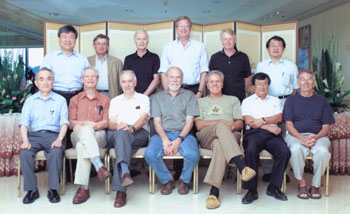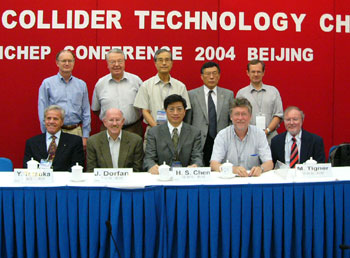The road to Beijing
by Neil Calder and Judy Jackson

|
It was 10 p.m. Thursday in California, midnight Thursday in Chicago, 7 a.m. Friday in Europe and 2 p.m. Friday in Japan when Jonathan Dorfan stood up to announce the recommendation of the International Technology Recommendation Panel in Beijing at 1 p.m. on Friday, August 20. In a breathless hush, 700 physicists waited in a huge auditorium at the International Conference for High Energy Physics. Around the world, particle physicists watched their computer screens. Dorfan's announcement would mark a critical milestone in the evolution of the International Linear Collider, the proposed next big facility for world particle physics.
After a tantalizingly complete introduction to the selection process, Dorfan, as chair of the International Committee for Future Accelerators (ICFA), finally came to the point the worldwide audience was anticipating. The 12-member ITRP, chaired by Barry Barish of the California Insti-tute of Technology, had recommended that the world particle physics community adopt "cold" superconducting accelerating structures, rather than "warm" 11.4 GHz X-band radio frequency (rf) structures, as the technology choice for the internationally-federated design of a new electron-positron linear collider.
"The decision was not an easy one," Barish said. "Both technologies were well advanced and we knew the selection would have significant consequences for the participating laboratories. Both the ‘warm' X-band technol-ogy and the ‘cold' superconducting technology would work for a linear collider. Each offers its own advantages, and each represents many years of R&D by teams of extremely talented and dedicated scientists and engineers. We interpreted our charge as recommending a technology, rather than choosing a design for an accelerator. We expect the final design to be developed by a team drawn from the combined warm and cold linear collider communities, taking full advantage of the experience and expertise of both."
The decision in Beijing was the final step in an ICFA-directed process that began in 1995 with the publication of the report of a Linear Collider Technical Review Committee, with Stanford Linear Accelerator Center's Greg Loew as chair. The report presented a standard-ized way of comparing the several emerging linear collider technologies in terms of parameters such as power consumption and luminosity.
In August 1999, ICFA issued a statement expressing worldwide commitment to a Linear Collider: "Scientific panels charged with studying future directions for particle physics in Europe, Japan and the United States have concluded that there would be compelling and unique scientific opportunities at a linear electron-positron collider in the TeV energy range."
In 2002, ICFA commissioned a second Linear Collider Technical Review Committee Report, again chaired by Greg Loew, and set up the International Linear Collider Steering Committee with Cornell University's Maury Tigner as chair. In its February 2003 report, the technical review committee concluded that both the warm and cold technologies had developed to the point where either would work for a linear collider. Then, in the autumn of 2003, the ILCSC set up the International Technology Recommendation Panel and charged its members, four each from Europe, Asia and North America, to recommend a single technology before the end of 2004.
In February 2004, ICFA restated its commitment to a linear collider at a meeting in Paris: "ICFA reaffirms its conviction that the highest priority for a new machine for particle physics is a linear electron-positron collider with an initial energy of 500 GeV, extendible up to about 1 TeV, with a significant period of concurrent running with the LHC."
The linear collider would require a new, thoroughly globalized approach to accelerator building and operation, necessitated by the scale of modern particle accelerators.
"Never before has a field of science attempted to globalize itself as extensively as HEP has done recently," Dorfan said at the Beijing meeting. "It is a challenging task, but one that we must do successfully. ICFA has been an essential body in helping to guide international cooperation on the linear collider."
The ITRP met six times, beginning in January 2004 at Rutherford Appleton laboratory in Oxfordshire, UK, where the panel estab- lished working methods and planned the rest of the process.
"We then visited the three labs that had the most important contributions to the warm and cold technologies," Barish said. "We went to DESY and SLAC in April and to KEK in June. I would like to thank the people at all the labs for the immense amount of work they put in to present the technologies to us. We then had two meetings to deliberate, first at Caltech in June and finally in Korea in August where we came to our decision. There was almost 100 percent attendance by all members at all meetings, which really underlines the commitment of this group."
University of Pisa physicist Giorgio Bellettini was among the European members of the panel.
"You must remember that most of us didn't know each other before the panel was set up," Bellettini said. "Barry Barish did a fantastic job in creating a group. He gave each of us a lot of homework. We all had to study like crazy!"
The panel created a matrix of six general categories with some 40 items total. The six main categories were: the scope and parameters specified by the ILCSC; technical issues; cost; schedule; physics operation; and more general considerations that reflected the impact of the ILC on science, technology and society.
"We evaluated each of these categories with the help of answers to the ‘questions to the pro-ponents,' that we sent to each laboratory prior to our visit, of internal assignments and reviews, and of our own discussions," Bellettini said.
Barish said that the features that the panel found particularly attractive for the superconducting technology follow in part from the lower frequency (1.3 GHz L-band) rf systems for accelerating the electron and positron beams.
"The large cavity aperture and long bunch interval reduce the complexity of operations," Barish said. "This helps to reduce the sen- sitivity to ground motion, it permits interbunch feedback, and it may enable increased beam current. The main linac [linear accelerator] rf systems, the single largest technical cost elements, are of comparatively lower risk. We also felt that the construction of the super- conducting XFEL free electron laser would provide prototypes and test many aspects of the linac. The industrialization of most major components of the superconducting linac is already underway. The use of supercon- ducting cavities significantly reduces power consumption, leading to a cost savings of several hundred million dollars over the life of the machine."
Looking back on the decision making process Bellettini said that there was no final show of hands.
"In fact, we never voted," Bellettini said. "Well, actually, we had a secret poll to test our feelings at some point in the process! We had the matrix of six categories and we gave our opinion on how each technology performed on these points. But this was a blind ballot— none of us knew, nor could later find out, how the others were voting. The collection of these votes indicated consistently a preference for the cold technology. A similar procedure brought us eventually to the final decision."
|
Bellettini said he found it interesting that geographic loyalties didn't creep into the process.
"You would have thought that with four rep-resentatives from each of the three regions people might have local sympathies for one or other of the technologies. It just didn't work out like that," Bellettini said. "As we all had to make multiple presentations, the whole process was very open, and we were all responsible for the information-gathering and analysis. It was impossible to be a bystander. I think it was a mixture of our unfamiliarity with each other at the start and the demands for a lot of work that made this group so successful. We all tried as hard as possible to give the best presentations: no one wanted to look foolish in front of such illustrious colleagues! As the process went on we got to know each other very well. I gained great respect for all my colleagues. We really were a team working together towards a conclusion, not factions trying to convince each other that one point of view was correct."
Barish emphasized that although the panel recommended cold rf technology, "we especially wanted to note the importance of the work that has been done on the warm technology. We need to fully capitalize on the experience from the Stanford Linear Collider, Final Focus Test Beam, Accelerator Test Facility and TESLA Test Facility. The range of systems from the electron and positron sources through to beam delivery is so broad that an optimized design can only emerge by pooling the expertise of all participants."
He also stressed the importance of the possibility of increasing the energy range of the machine.
"The linear collider will be designed to begin operation at 500 GeV, with a capability for an upgrade to about 1 TeV, as the physics requires," Barish said. "This capability is an essential feature of the design; the global R&D and design effort should be focused on increasing the ultimate collider energy to the maximum extent feasible."
After the drama of the technology choice, what is the next step on the road from Beijing?
"In November 2004 we will form the Inter-national Linear Collider collaboration at a workshop at KEK, which will bring together all the interested worldwide partners," said ICFA's Dorfan. "By the end of the year, we plan to identify a director for the central design effort. This director will lead the Global Design Initiative, with regional coordinators from each geographical area. After the design is com-plete, the next step will require one or several governments to come forward with an offer to host the facility."
At the conclusion of the technology selec-tion process, Bellettini looked back with mixed feelings. "It was very sad to say goodbye to all the other members of the panel in Korea," he said. "We had worked together really well and become good friends. Sad but no regrets, as we all knew that this panel had worked well. The internal dynamic was really strong and we were satisfied that we had done a good job."
Barish concurred. "We worked incredibly hard, giving up a good part of our normal day jobs for about six months," he said. "We read approximately 3000 pages, and each of us traveled at least 75,000 miles. A TeV scale electron-positron linear collider is an essential part of a grand adventure that will provide new insights into the structure of space, time, matter and energy.
"We believe that the technology for achieving this goal is now in hand, and that the prospects for its success are bright."
Click here to download the pdf version of this article.







